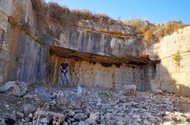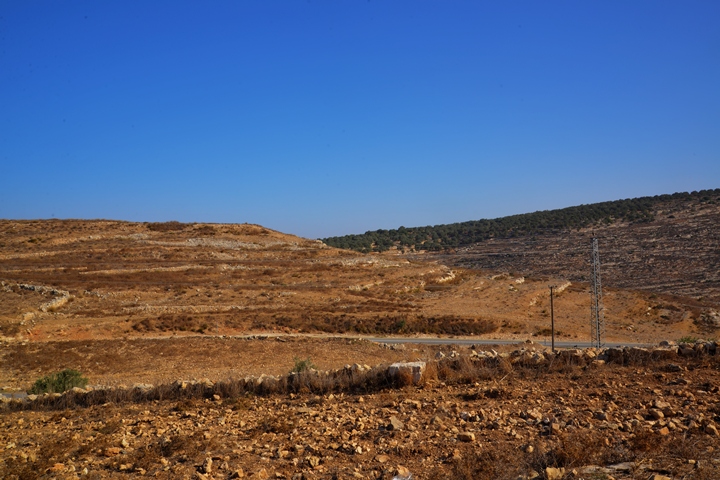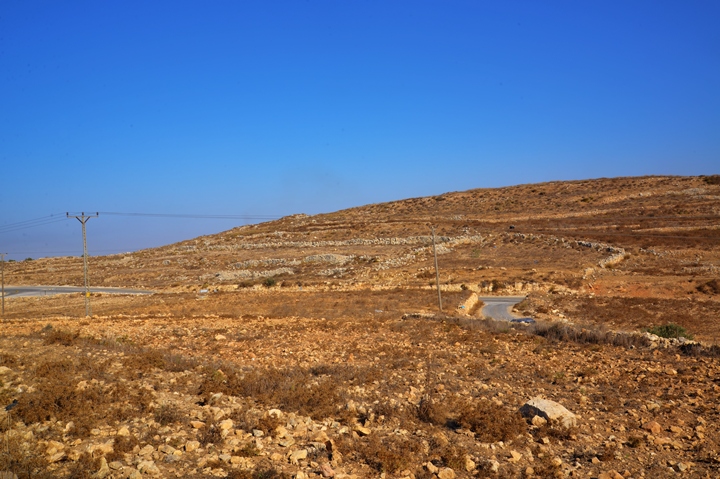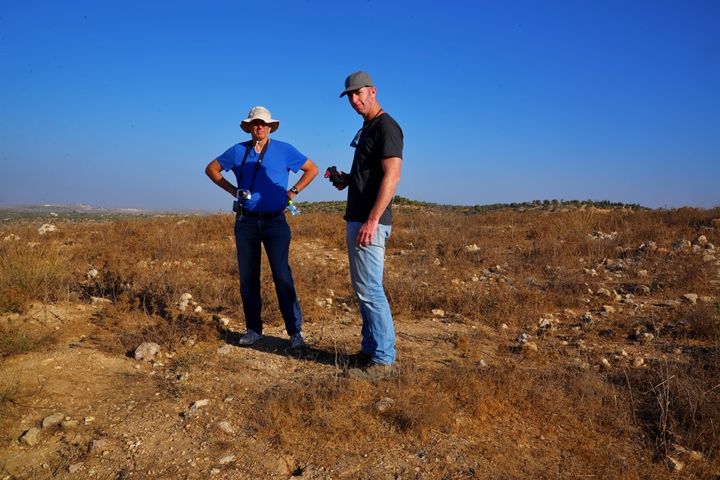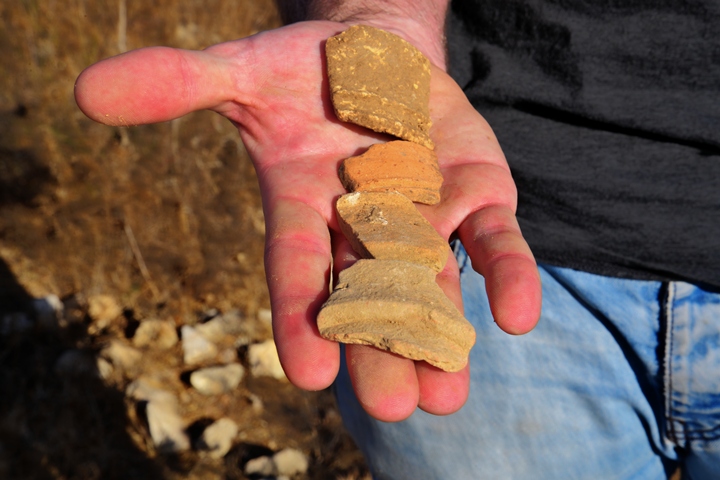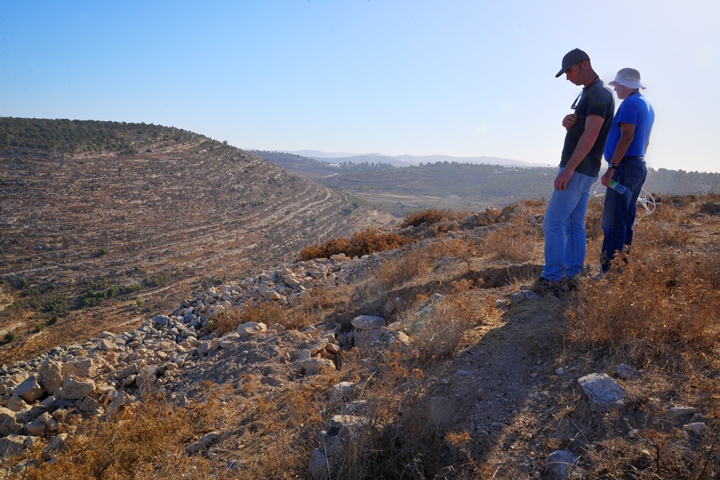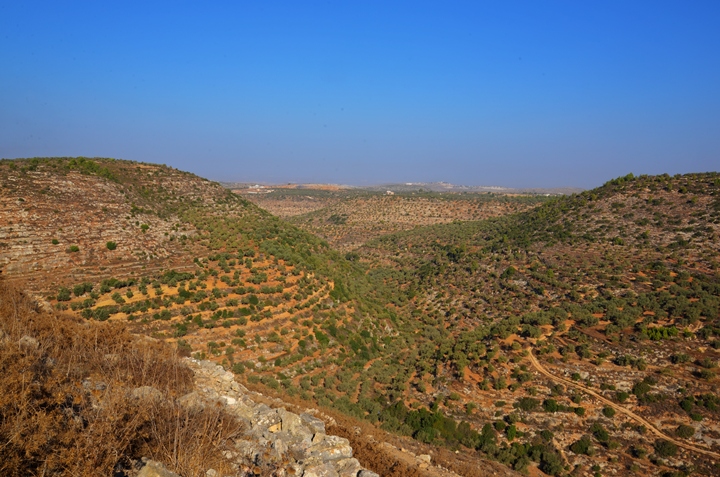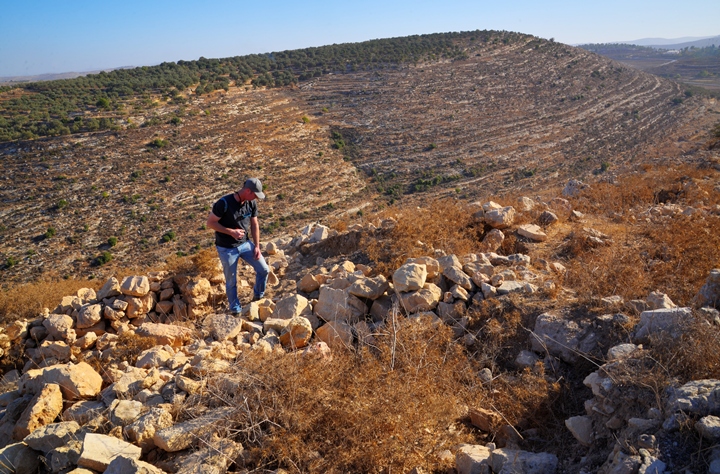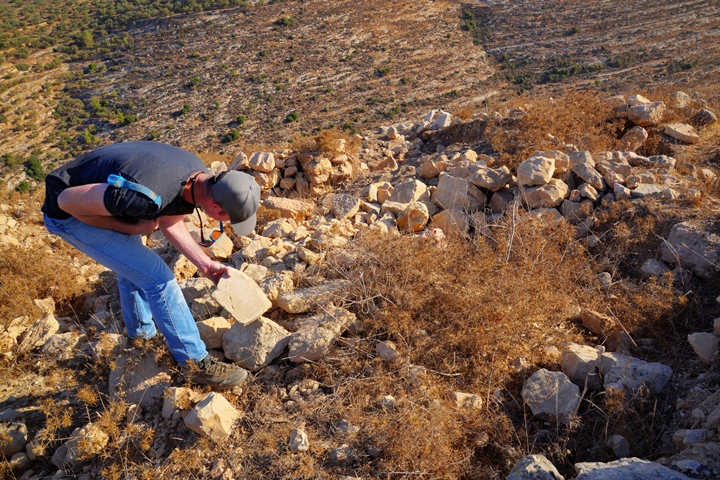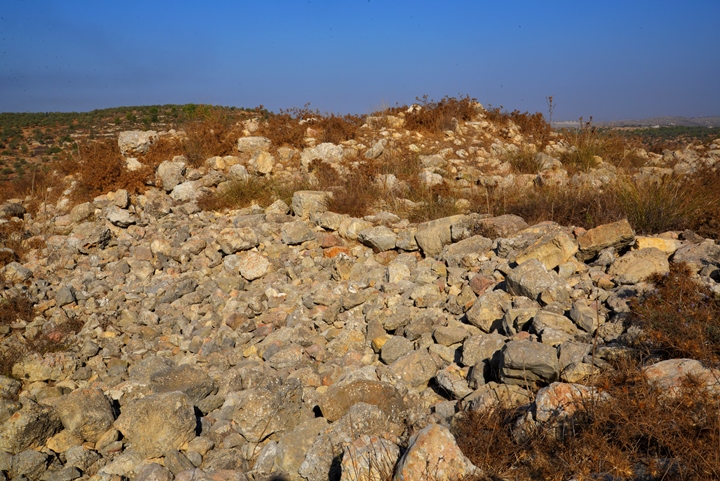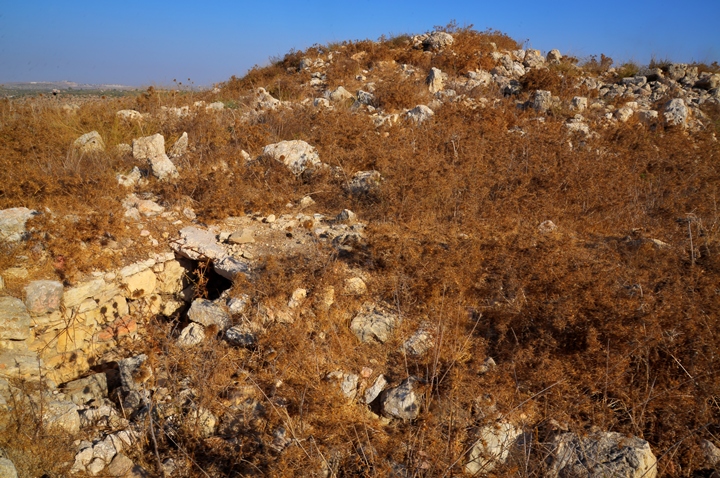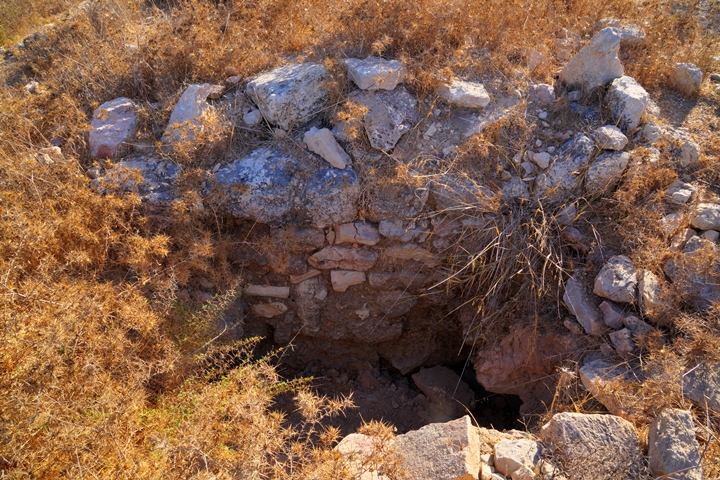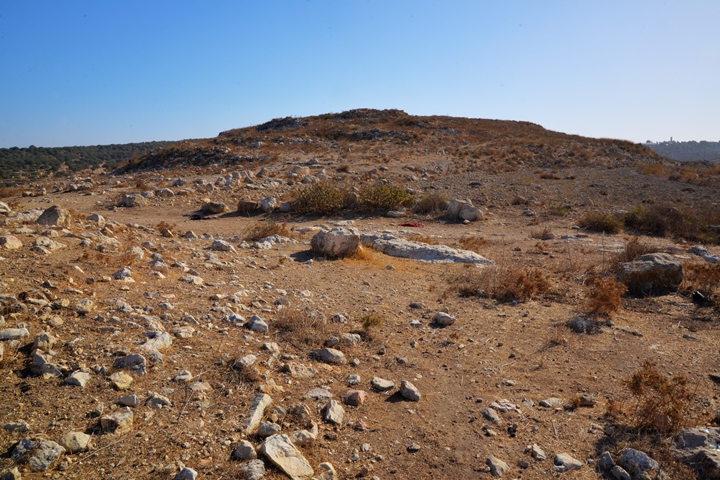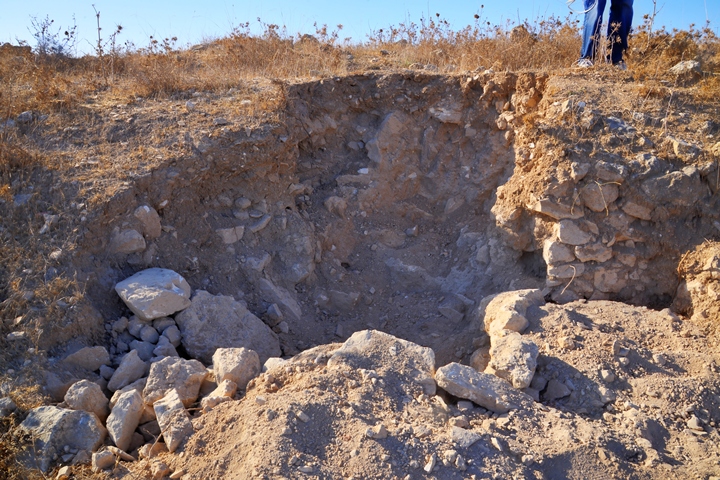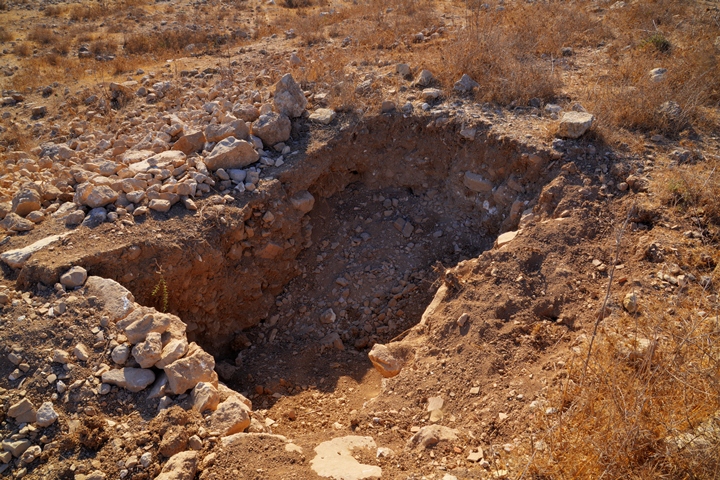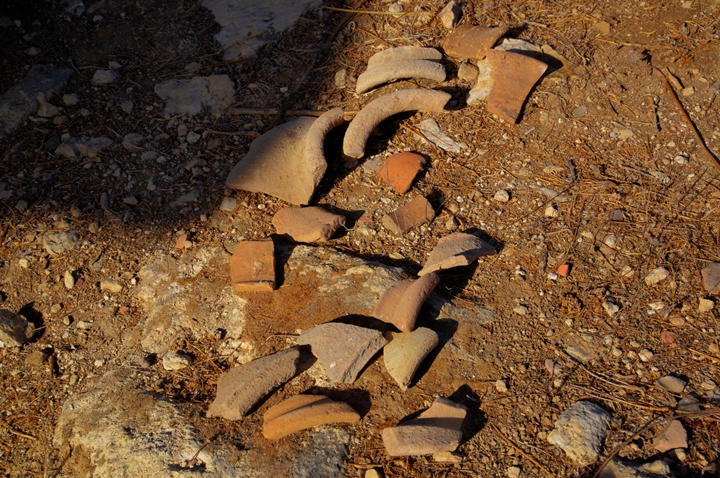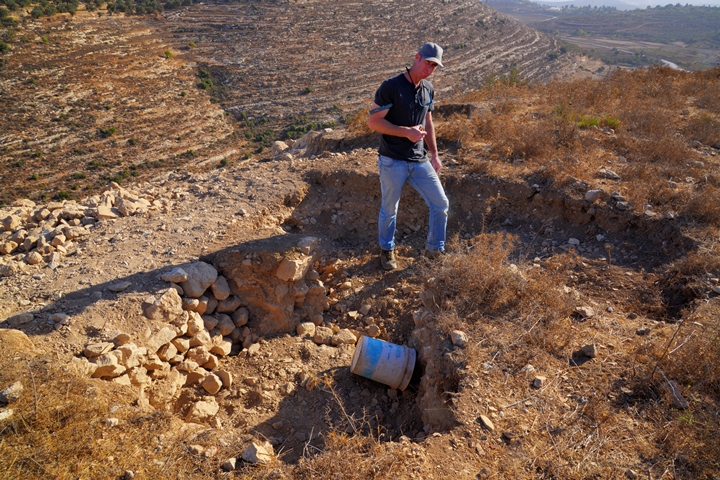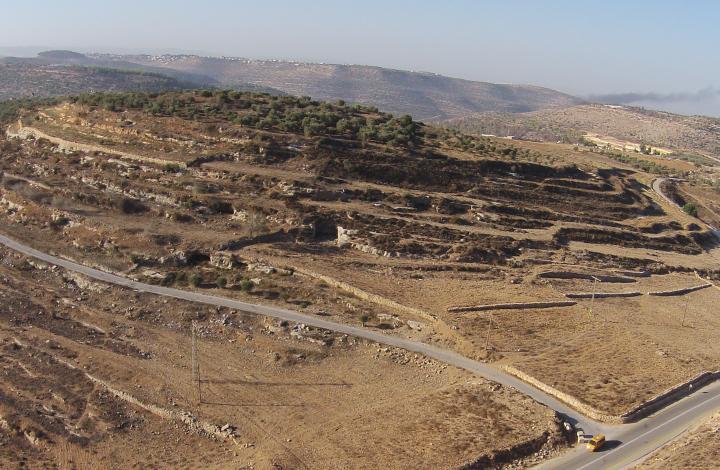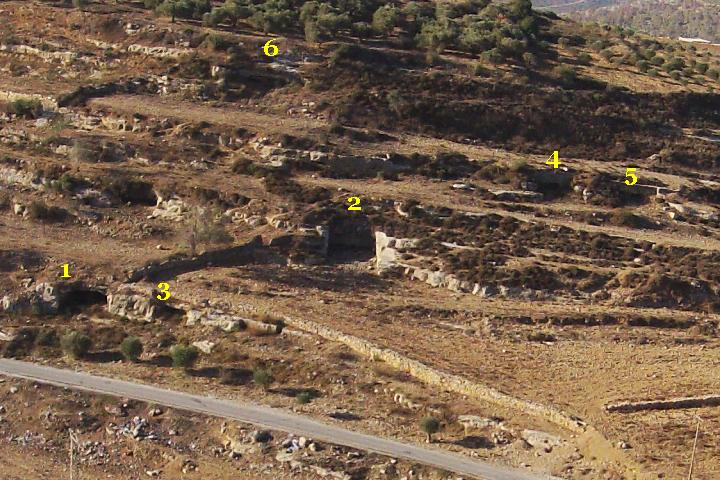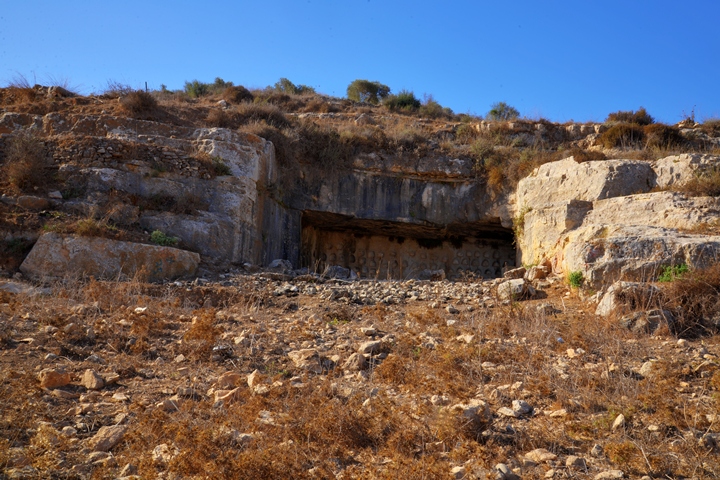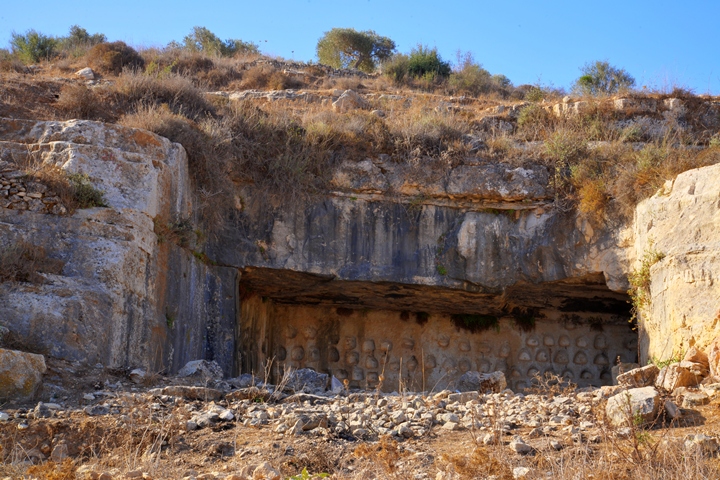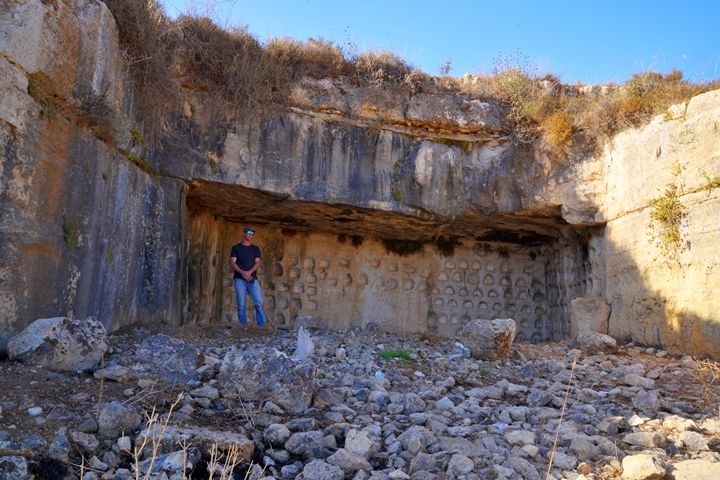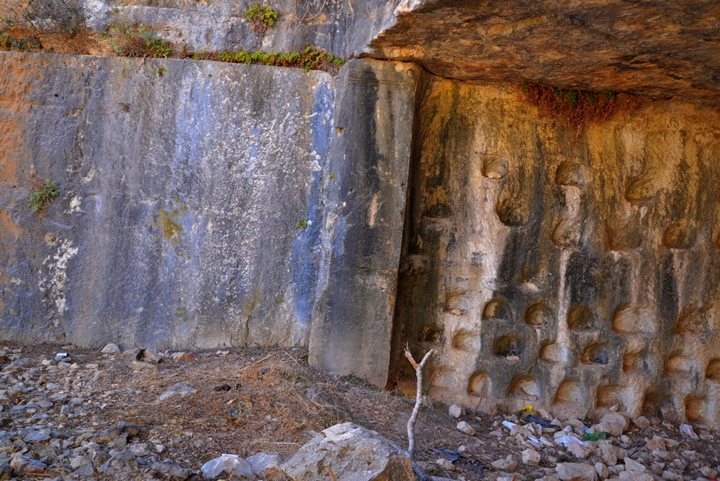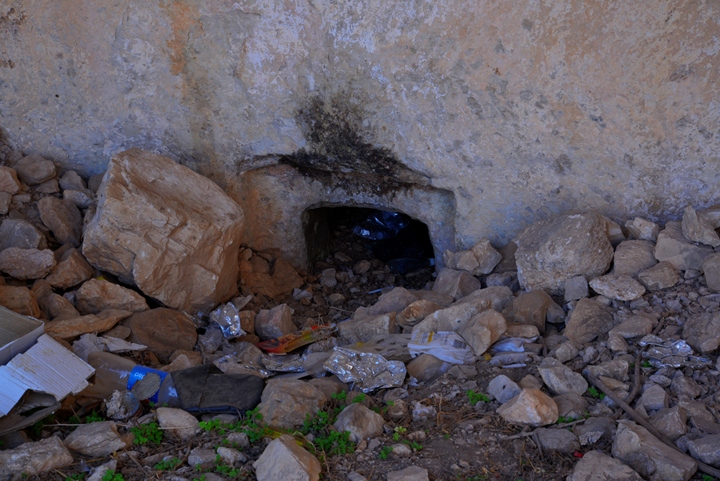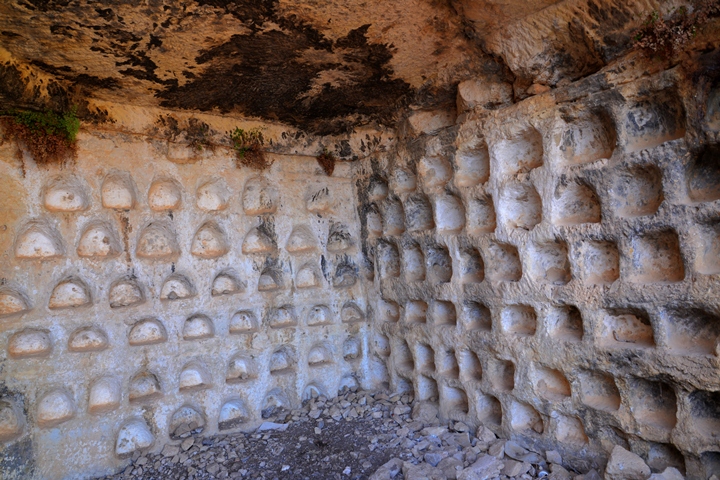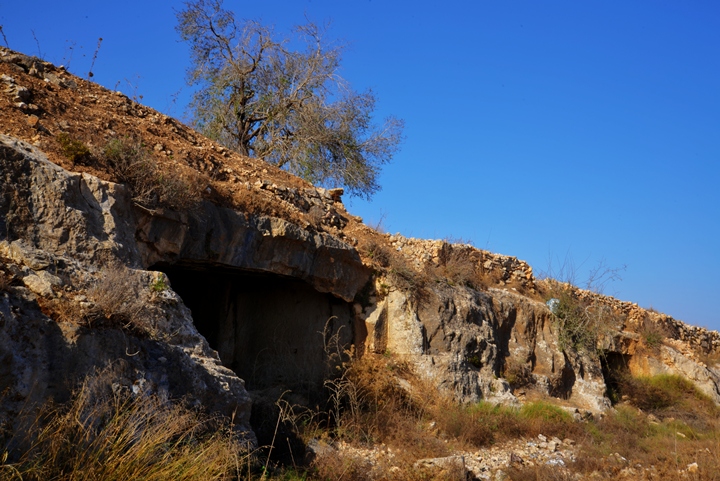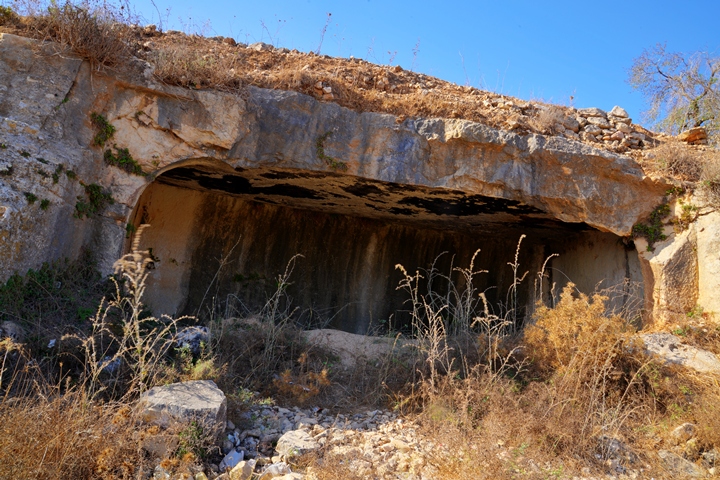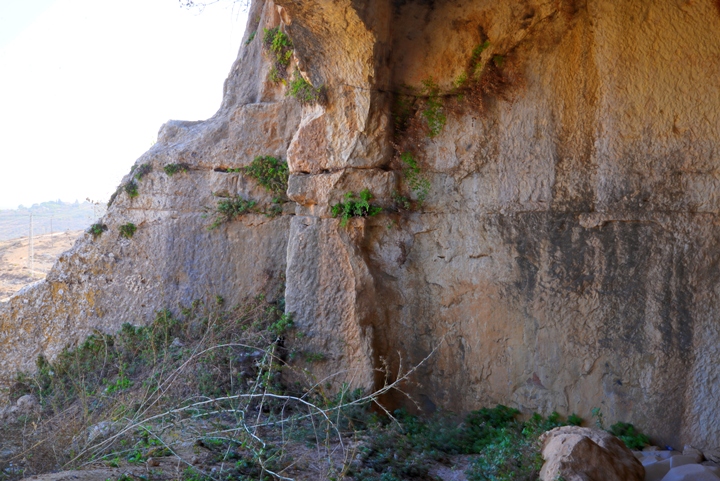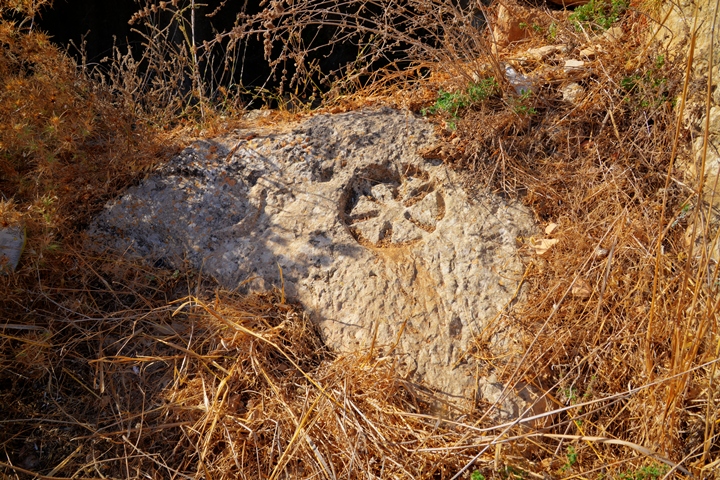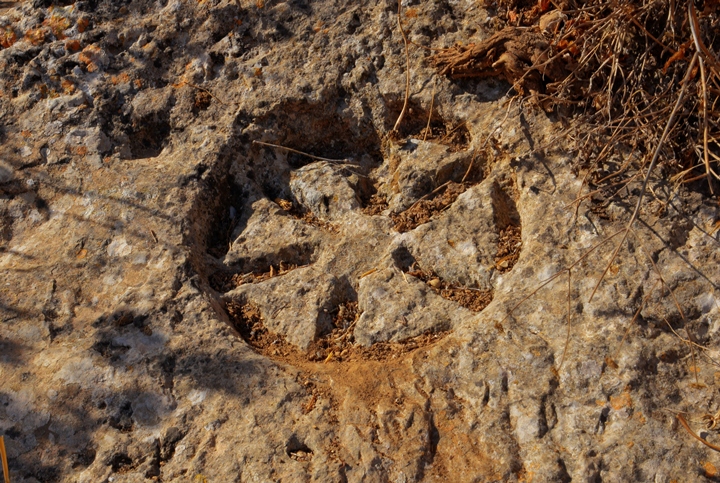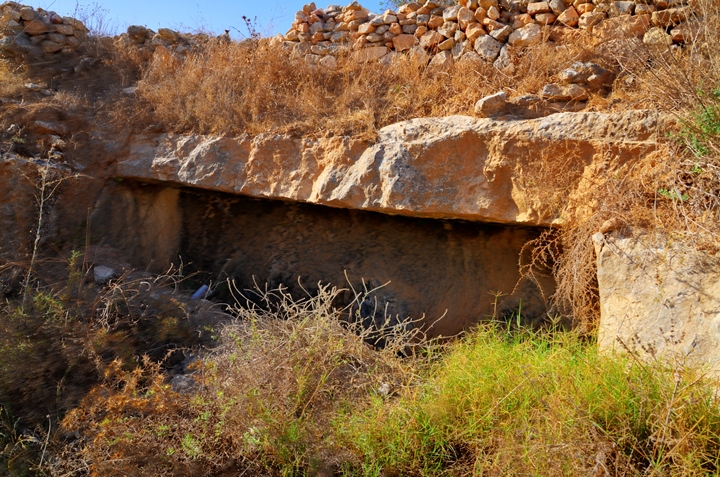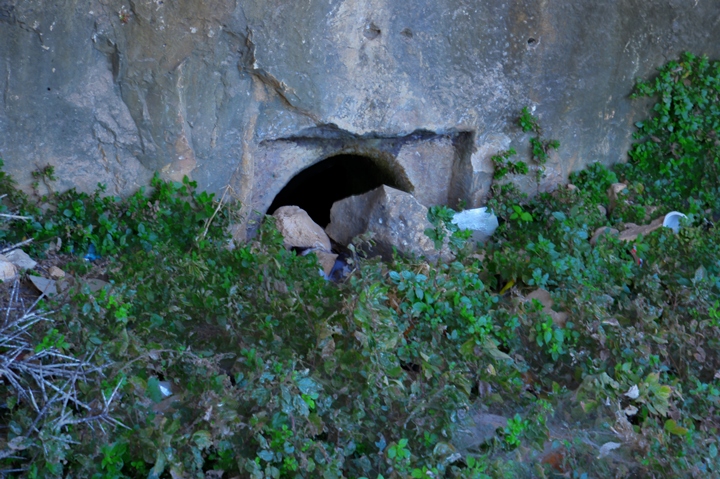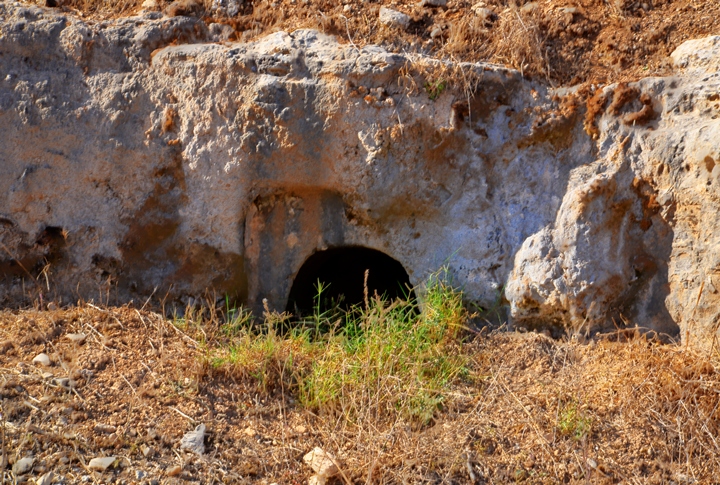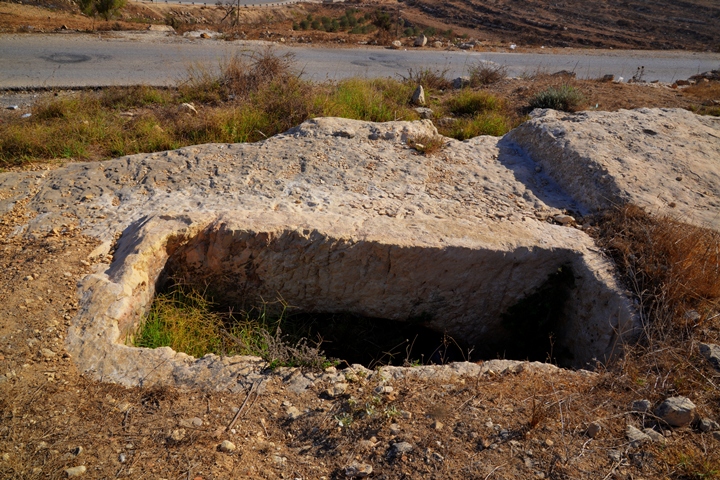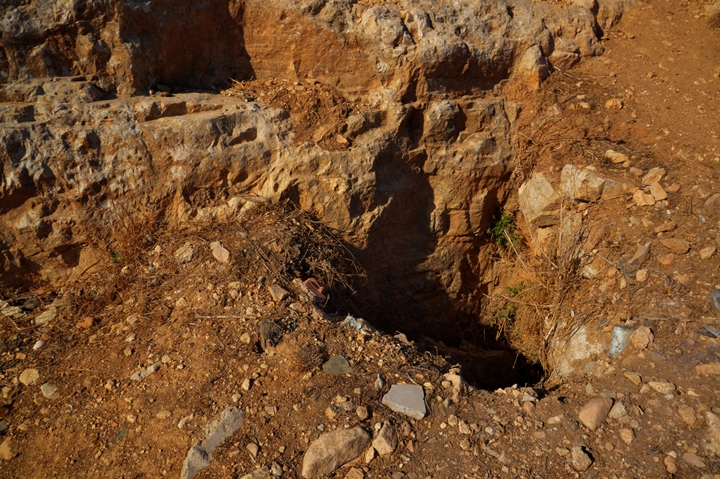Kh. Tibneh, in the hill country of Ephraim, is identified as Timnath-Serah or Timnath-Heres- the burial-place of Joshua according to the Bible.
* Site of the Month Aug 2017 *
Home > Sites > Samaria > Tibneh (Timna, Timnath, Thamnata)
Contents:
Background
Location
History
Photos
* Aerial Photos
* Ground views
* Summit
* West side
* Illicit diggings
* Necropolis
* Tomb of Joshua
* Other tombs
* Mikveh
Etymology
Links
Overview:
Kh. Tibneh, in the hill country of Ephraim, was a Hellenistic and Hasmonean fortress that protected the road from Antipatris to Gofna. The Biblical city is identified as Timnath Serah – the residence of Joshua (Joshua 19:50) and his burial-place (Joshua 24: 30): “And they buried him in the border of his inheritance in Timnathserah, which is in mount Ephraim, on the north side of the hill of Gaash”).
Location and map:
This ancient Tel is located on a high hill, alt. 545m, in the south west Samaria hills, overlooking the valley of Wadi Reiya. The Tel is located on the side of road #465, about 2km west of Halamish, near the road to Deir Nidham. Its ruins cover an area of 50 dunams (5 hectares), some of them buried under the modern road. An ancient cemetery (necropolis) is located across the road on the south side.
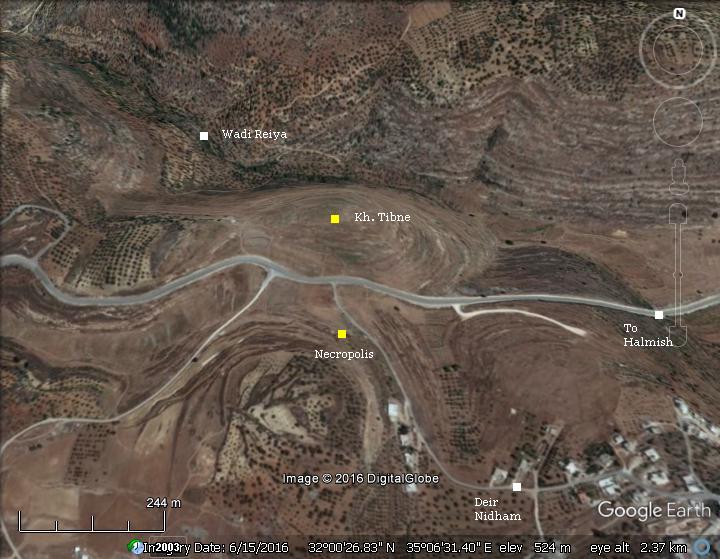
History:
- Canaanite period (Bronze period)
The city was fortified during the Canaanite period, long before the conquest of Joshua. Its steep foothills provided a natural defense. The early period of the city, according to the pottery shreds collected in the surveys, was from the Middle Bronze II period.
The other Biblical name of the city, Timnath-Heres (Judges 2:9), may refer to the name or nature of the Canaanite city. ‘Heres’ means sun, implying that the Canaanite city that predated Joshua’s conquest worshipped the sun, similar to other cities in the Levant (such as Beit Shemesh – house of sun).
- Biblical times – Judges period (Iron Age I)
The peak of the city was in the Iron Age I period – the times of Joshua. According to the Bible, Joshua lived in Timna Serah (Timna) after he led the conquest of Israel (Joshua 19:50-51): “When they had made an end of dividing the land for inheritance by their coasts, the children of Israel gave an inheritance to Joshua the son of Nun among them: According to the word of the LORD they gave him the city which he asked, even Timnathserah in mount Ephraim: and he built the city, and dwelt therein.”
Joshua was also buried in Timna (Joshua 24:29-30): “And it came to pass after these things, that Joshua the son of Nun, the servant of the LORD, died, being an hundred and ten years old. And they buried him in the border of his inheritance in Timnathserah, which is in mount Ephraim, on the north side of the hill of Gaash”.
The burial place is also mentioned in Judges as Timnath-Heres (Judges 2:9): “And they buried him in the border of his inheritance in Timnathheres, in the mount of Ephraim, on the north side of the hill Gaash”.
A Biblical map is shown here. An ancient route, indicated by a dashed line, passed on the side of Thamnatha (the Greek name of Timna/TimnathSerah, which is marked with a red circle). That route connected the Shephela to the hills of Samaria, via Gophna.
Roads and cities during the Israelite period thru the Hasmonean period, 12th 1st century BC (based on Bible Mapper 3.0)
- Iron Age II
An administrative city was located here during the Israelite Kingdom.
- Persian Period (6th-4th century BC)
The city was rebuilt during this period, but it is not known whether it was settled by Jews, Samaritans or others.
- Hasmonean (2nd-1st century BC)
The Maccabees headed the anti-Hellenization rebellion against the Greek Seleucids who controlled the land of Israel during the second half of Hellenistic period (4th – 1st century BC). After a series of successful military campaigns they took control of Judea, liberated the land and created an independent Jewish country in 164 BC.
The Seleucid general Bacchides was sent to Judea in 161 BC in order to quell down the rebellion. (1 Maccabees 7:8-9): “Then the king chose Bacchides, one of his friends that ruled beyond the great river in the kingdom, and was faithful to the king: and he sent him, To see the havock that Judas had made… and commanded him to take revenge upon the children of Israel…”
Bacchides fortified Tibneh, among other forts north of Jerusalem. The importance of the fortress in Timna, now named Thamnata, was for protecting their supply chain from the North, as it commanded one of the strategic roads from the plains to Jerusalem (1 Maccabees 9:50-51): “…And they built strong cities in Judea, the fortress that was in Jericho, and in Ammaus, and in Bethoron, and in Bethel, and Thamnata, and Phara, and Thopo, with high walls, and gates, and bars. And he placed garrisons in them, that they might wage war against Israel”.
Jonathan Maccabee succeeded Judah after his death in the battle of Elasa, where Bacchides the Hasmonean army. Jonathan managed to recuperate from their defeat and persecution by Bacchides, and won the great battle of Yavneh (147 BC). After the battle, the Seleucid King Demetrius II gave Jonathan, as part of a new alliance with the Hasmonean Kingdom, 3 provinces (Lydda, Ramatha and Efraim) in western Samaria (Josephus Antiquities, Book 13 4:9): “Accordingly, I remit to them the three prefectures, Apherims, and Lydda, and Ramatha, which have been added to Judea out of Samaria…”.
The Hasmoneans then fortified the city, which was part of the new province of Ramatha and commanded the route from Gofna.
- Herod the Great, early Roman period (1st Century BC-1st century AD)
The peak of the city was during the early Roman period, as part of the Herodian kingdom. Timna/Thamnata became the capital city of the Timna province, which was settled by Jews.
- Revolts against the Romans (66-70, 132-136 AD)
The archaeologists determined that the Jewish population in Thamna survived the great revolt against the Romans (66-70 AD), and continued to inhabit the city until the Bar Kokhbah revolt (132-136 AD).
After its destruction, the Jewish population ceased, as all other Jewish villages in northern Judea. Cassius Dio, the historian of Rome, wrote about the devastation of Judea (Roman History, LXIX 13): “Fifty of their most important outposts and nine hundred and eighty-five of their most famous villages were razed to the ground. Five hundred and eighty thousand men were slain in the various raids and battles, and the number of those that perished by famine, disease and fire was past finding out. Thus nearly the whole of Judaea was made desolate, a result of which the people had had forewarning before the war”. Jews were forbidden to return to all settlements in the vicinity of Jerusalem. Eusebius of Caesarea wrote about this ban in the 4th century (Church History, Book IV, Ch. 6, 3): “…the whole nation was prohibited from this time on by a decree, and by the commands of Hadrian, from ever going up to the country about Jerusalem. For the emperor gave orders that they should not even see from a distance the land of their fathers..”.
Following the destruction, the city was resettled by pagans.
- Late Roman and Byzantine periods (2nd century AD – 7th century)
In the Roman/Byzantine periods Thamna, as it was called then, became the headquarters of a toparchy.
Roman road: A major Roman road passed at the foothills of Thamnata, connecting Lydda and Antipatris (Aphek) through Gofna to Shechem and Jerusalem. The Peutinger Map (Tabula Peutingeriana), which a section of it is shown here, is a medieval map which was based on a 4th century Roman military road map. The map shows the major roads, with indication of the cities, and geographic highlights (lakes, rivers, mountains, seas). Along the links are stations and distance in Roman miles (about 1.5KM per mile). The map is drawn with west upwards.
In the center of this section is the area of Samaria. Thamnata is marked (by Biblewalks) as a red square. Above it is Lydda (“Luddis”), after a sharp turn left (at Lubban). Gofna is below it, connecting right to Shechem (“Neapolis”, XX miles from Gofna), and left to Jerusalem (XVI miles).
p/o Peutinger map of Roman roads; site is marked
-
Survey of Western Palestine
Conder and Kitchener of the Palestine Exploration Fund (PEF) surveyed the area during the Survey of Western Palestine (SWP) in 18734-75. They described the site in details (volume 2, pp 374-378):
“Tibneh – A Tell 200 yards east and west by about 100 yards north and south, with a deep rugged valley (Wady Reiya) on the north and flat low ground to the south, where is the Roman road ; 100 yards south is a flat hill, in which is the cemetery of the town. On the north-west is ‘Ain Tibneh, a spring of good water emerging in a rocky channel. On the south-west is Sheikh et Teim, a noble oak tree some 30 or 40 feet in height, and perhaps the largest tree to be found in Palestine; by it is a modern well, and a little further east a dry well. West of the tree are traces of ruins. The tree is fully covered with foliage, the leaf being extremely small.
There are remains of walls on the west side of the Tell, apparently remains of an Arab village, and quite modern. Beside the road, further east, there is, however, the foundation of a wall of drafted stones ; one measured 2 feet 2 inches by 2 feet 3 inches, and had a draft 3 inches wide, 2 inches deep, the boss roughly dressed.
No. 3 is a tomb, with a portico measuring 25 feet by 10 feet. It has two piers and two pilasters, and, between these, entrances with semicircular arches cut in the rock, about 6 feet span. Over these is a rude ornamentation much worn, which appears to have represented festoons, wreaths, and rosettes, much more rudely executed than those of Mokatd A bud, but in the same style. There was originally a cornice above, now broken away. The tomb is choked – only the top of the door visible.
No. 4 is only a koka cut in the rock. No. 7 has a porch 7 feet by 12 feet 2 inches, and a chamber within with 15 kokim, 5 on each wall. The doorway is damaged.
There are remains of the ancient pavement of the Roman road close to this site.
Visited 6th June, 1873″
Part of map Sheets 14 of Survey of Western Palestine, by Conder and Kitchener, 1872-1877.
(Published 1880, reprinted by LifeintheHolyLand.com)
Their report also added Victor Guerin’s report (p. 376) and added a map of the site:
“Guerin found on the hill the ruins of a small square tower, built of medium-sized stones, and containing two ancient cisterns. On the top of the hill he saw the remains of a burj of Arab appearance. ‘The hill on three sides looks over deep ravines : on the south it gradually slopes towards a valley covered over with habitations. Here is a birket, 30 paces long by 15 broad, with several cisterns cut in the rock.'”.
PEF report – plan of Tibneh Vol 2 p. 375i
- Modern Period
The site was surveyed in the 19th century by Guerin and the PEF team, who focused on the necropolis. Their report was listed above.
In 1968, right after the 6 day war, it was surveyed by R. Gofna and Y. Porath. Finkelstein and Lederman surveyed the site in the early 1980s. Michel Yitach surveyed the cistern which was first used as a ritual bath (mikveh).
The site is an open public area and is easily accessed from the road west of Halamish (Neveh Tzuf) community.
First season of excavations started in August 2021, led by Dr. Dvir Raviv.
Photos
Visit to the site was made possible and guided by the archaeologist Dr. Dvir Raviv, and we thank him for this.
(a) Aerial Photos
This aerial view shows the eastern side of the hill. The ruins cover an area of 35 dunams.
Click on the photos to view in higher resolution…
The hill is surrounded by steep foothills on its northern and eastern sides. This topographic layout provided a natural defense to the ancient city.
A modern road traverses its southern foothill, using the same route of the ancient route from the coastal area to the center of Samaria, from Aphek to Gophna.
The next aerial view shows the steep northern side of the hill. The valley (Wadi Reiya) is lower by 70m below the summit. On the north west foothills is a small spring (Ein Tibneh).
![]() The following YouTube video shows a flight of a drone over the site.
The following YouTube video shows a flight of a drone over the site.
(b) Ground views
This photo, taken from the south side, shows the east side of the hill. The modern road follows the same route of the Roman road. The height difference on this side of the hill is only 30m.
The next photo shows the western side of the hill.
(c) Summit
On the summit are few visible structures, as the site was not yet excavated.
The majority of the ceramic fragments were dated from the Iron I, Iron Age II thru the Early Roman period ages.
Across the summit and the foothills are scattered ruins.
The hill overlooks the deep valley of Wadi Reiya.
The foothill on this side and the northern side are very steep. Bases of walls and structures are scattered along the foothills.
Some heaps of stones are located on the summit.
On the south side, above the road, are ruins of Jordanian fortifications that were constructed before the 6 day war.
(d) West side
On the west side of the hill are additional remains of the ancient city. This view from the west is towards the summit which is seen in the background.
A view towards the west:
(e) Illicit diggings
Sadly, this site is witnessing a large scale looting, as many other archaeological sites in Samria and Judea, especially in the Palestinian controlled areas where the Israeli authorities cannot legally prevent illicit digging.
This illicit activity causes irreversible severe damages to the historic sites.
Robbers seek valuable findings that could be sold in the black market. They toss away ceramics fragments that could not bring in profit, so the site is scattered with fresh thrown away fragments.
Dvir sadly inspects the results of the diggings.
(f) Necropolis
Across the road, on the south side of Khirbet Tibneh, is another ruin named: Khirbet Baluta. The Arabic name means the “ruin of the oak”, based on the large oak tree that once grew here.
The Bible described the location of Joshua’s burial place as being north of Mt. Gaash, which may have been the name of this hill, as the tomb of Joshua is identified on its north east side.
On the north eastern side of the hill is the necropolis (cemetery) of Tibneh. Sixteen tombs are cut into the rock, 8 of them are monumental tombs. These are dated from the end of the second temple period up to the Bar Kokhbah revolt (1st century BC to 2nd century AD). Six other tombs were located on the south east and north west foothills of Tel tibneh.
The tombs are identified mostly as tombs of wealthy Jewish families. Their design and decorations are similar to the second temple period tombs found in Jerusalem – dressed facades with friezes and antechambers.
A closer view shows some of the tombs. They are numbered (1 through 6) as in Dvir’s article on magnificent tombs of second temple period in Western Samaria.
(g) Joshua’s tomb
Cave #2 is the most important tomb. Scholars, such as Victor Guerin (1821-1891), identified it as the tomb of Joshua.
This monumental tomb, cut into the rock, has a plan of an open rectangular court.
The tomb consists of a portico (porch leading to the entrance of a building), an antechamber (small room leading to the inner room), and an opening into the burial chamber which is cut in the center of the southern wall. In the 19th century there were two pillars standing in the middle of the opening, but since then they have been removed. The tomb may have had a decorated frieze (wide central section) above the entrance, but it was lost over time.
Two side rectangular columns flank both sides of the burial complex. The left side is shown in the photo below.
The entrance to the burial chamber is in the center of the wall. The recess around the opening was used to seal the entrance. It opens to a large inner chamber with three sets of 5 kuchim (burial niches) each, then continues to another burial chamber with a large single kuch – the burial place of the distinguished member of the family.
The PEF report described this tomb (Volume 2, P. 375):
“Nine tombs were here observed, of which five were closed up with rubbish. The first tomb furthest west (sometimes called Joshua’s Tomb) has a porch in front of it 11 feet high, 24 feet long, 10 feet 10 inches broad. In front of this were two pilasters and two piers of rock about 2 feet square. Both the piers were standing in 1866, but one had disappeared in 1873. The rock extends 26 feet 6 inches in front of the facade, in continuation of the line of the side-walls of the porch. The piers and pilasters are rudely cut, and not square ; they have capitals with a very simple molding. The rock above is covered with bushes. The facade inside the tomb is remarkable for the number of niches for lamps, arranged in rows but not symmetrical’. There are over 200 of these niches, and they are all blackened with smoke.
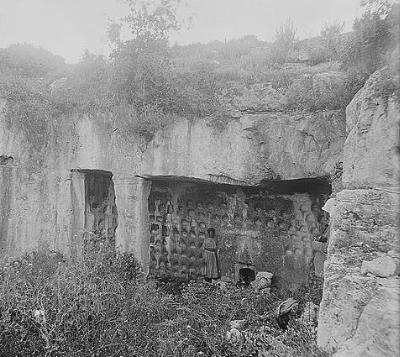
The tomb in 1900-1920 Matson collection, Library of Congress
The inner chamber is entered by a small square doorway about 2 feet 2 inches broad. The chamber within is 13 feet 9 inches to the back, and 13 feet 6 inches broad. A bench or mastabah 3 feet 4 inches wide runs round the side and back walls. The central part is much filled with rubbish. The height from the bench to the roof is 6 feet. There are 15 kokim, 5 on each wall, about 6 feet 9 inches long, and about 2 feet broad. They are not parallel, but pointed outwards like a fan. They are rudely cut, but have arched roofs, and are recessed to hold a square slab in front.
p/o PEF report, Volume 2 P. 375
The koka is 2 feet 9 inches high, the slab recess 3 feet. The middle koka at the back is converted into a passage 3 feet 4 inches broad, 7 feet long, 2 feet 9 inches high, leading to an inner and thus probably more recent chamber, which is trapezoidal, 8 feet 1 inch to the back. 7 feet 7 inches broad at the back, 9 feet 3 inches at the front, 5 feet 5 inches high. On the left a niche for a lamp ; at the back a koka 7 feet 5 inches long and 2 feet 5 inches broad. Its floor is some 3 feet above that of the chamber. There is an attempt at ornamentation in a kind of small pendentive of rock left in each corner of the chamber”.
Columbarium: In later years the tomb was converted to a Columbarium, by adding a wall in front of the court in order to enclosed it. Small niches were cut into the walls of the antechamber.
The word ‘columbarium’ is based on the Latin word columba (‘pigeon’), as it was used for a place to house doves and pigeons. This agriculture use of the birds was for their meat, while the bird droppings were used as a fertilizer for growing food. Initially, the concept of the early explorers who visited the tomb was that these niches were used to place candles to honor the dead.
- Is this the tomb of Joshua?
The PEF report supplied arguments for the identification of Joshua’s tomb and the identification of Tibneh as Joshua’s residence (volume 2, pp. 376-378):
“Guerin describes the tomb in much the same words as Lieutenant Conder. He adds, however, an interesting fact. It is that the fellahin only opened the inner chamber shortly before his own visit in 1863, and they found in it a sort of candelabrum, with three branches in yellow metal, and very heavy, which they sold to an officer of Bashibazouks for fifty piastres. The natives called the place Khubbet el Endieh. He then goes on to give his reasons for believing this to be the veritable tomb of Joshua. They may thus be summed up :
(1.) It is a magnificent tomb, evidently designed for some Prince in Israel.
(2.) The presence of the niches, not only in the chambers, but also in the vestibule open to the daylight, proves that it was a tomb held in the highest reverence.
(3.) Joshua asked for, and obtained, for his lot, the city of Timnath Terah, in Mount Ephraim. Here lie was buried ‘on the north side of the hill Gaash.’ The Septuagint (Joshua xxiv. 30) renders Gaash by Galaad. It also adds that the knives with which Joshua had circumcised the people were placed in his tomb with him. And the Serah or Heres became in the Septuagint Saracl: or Sachar.
(4.) The modern Tibneh faces the northern slope of a hill, on which stand the tombs described. May not this be Mount Gaash ?
(5.) The tomb of Joshua was known in the time of Eusebius and of Jerome. Paula visited the tomb, and says that the tomb of Phinchas was at ‘Gabaa,’ which corresponds to the modern Jibia.
(6.) Eusebius goes on to say that the town of belonged to the tribe of Dan, which could never be said of Kefr Haris, the rival site.
(7.) The tomb is of the greatest antiquity : the pilasters have no other ornamentation than a simple moulding.
(8.) The tomb has been planned and measured by De Saulcy, and on his drawings a careful study has been made by M. Aurfes, published in the Jievue Archeologique. He asserts in this paper that the measure used was the Egyptian royal cubit of seven palmsbrought by the Hebrews from Egypt.
(9.) As to the ‘knives’ placed in Joshua’s tomb. In the year 1870 the Abbe Richard found at Gilgal a large number of flint knives. At the request of M. Guerin he visited the tomb at Tibneh, and found in the kokim a large quantity of flint knives exactly similar.
All these facts together seem to M. Gue’rin to make out a very strong case for Tibneh”.
(h) Other tombs
- Second monumental tomb
The second monumental tomb, #1 on the plan, had also two columns in the center of the court. They too are gone.
The entrance to the burial cave had two semicircular arches. A section of the leftmost arch can be seen here on the left side.
The tomb consists of a portico (porch leading to the entrance of a building) and an opening into the burial chamber which is cut in the center of the wall. It led to a large inner chamber with 15 kuchim (burial niches).
The column on the side of the entrance is seen in the following photo.
The geometric form of a rosette, seen on the stone fragment below, was used to decorate the frieze (wide central section) above the entrance. It broke down and now the stone fragment lies near the entrance.
On the right is a drawing by the 19th century PEF survey team, when the cornice (horizontal decorative feature) of the rosette was still decorating the frieze. The arched entrances are also seen still standing. The report described the tomb:
“No. 3 is a tomb, with a portico measuring 25 feet by 10 feet. It has two piers and two pilasters, and, between these, entrances with semicircular arches cut in the rock, about 6 feet span. Over these is a rude ornamentation much worn, which appears to have represented festoons, wreaths, and rosettes, much more rudely executed than those of Mokatd. A bud, but in the same style. There was originally a cornice above, now broken away. The tomb is choked – only the top of the door visible”.
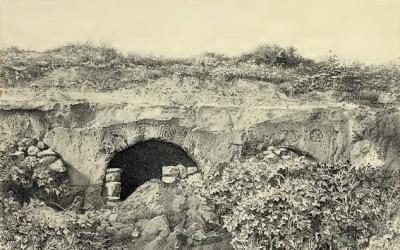
Drawing by the PEF team, Vol 2 p. 376i
A closer view of the rosette is seen in the next photo.
- Other tombs
The other monumental tombs share the same plan as the previous two. The entrance to another tomb (#3) is seen here:
Another entrance to a burial chamber, with the same design as in the first burial chamber:
Yet another entrance:
A Roman/Byzantine rectangular cist tomb is also found here:
(i) Public Mikveh
Another interesting structure that was found here is a large public ritual baptismal (mikveh). It serviced the travelers that passed here along the ancient route, and also was used by the visitors to the Necropolis to purify themselves after the visit.
The mikveh has two 1m wide openings, and a 5.5m x 6.5m underground pool with an estimated height of 4m. The walls and floor are covered by two layers of plaster, which were dated to the end of the Hellenistic period.
The double entrance design is common in Jewish ritual baths, as one was used for entry while the other for exit, in order to separate the impure entry from the purified exit.
Etymology (behind the name):
* Names of the place and vicinity:
- Timnathserah – name of the residence and burial place of Joshua, in the book of Joshua
- Timnath Heres – name of the burial place of Joshua, in the book of Joshua. ‘Heres’ means sun, implying that the Canaanite city that predated Joshua’s conquest worshipped the sun.
- Timna – another form of the name of the Biblical city
- Thamnata – Hellenistic period name
- Har Gaash – the burial place was located north of that hill, which may have been the hill across the road
- Deir Nidham – Arabic: the monastery of the marshal
Links and References:
* External:
- Looting in the west bank Adel H. Yahya (2010)
- Joshua’s tomb location – Dvir Raviv (Hebrew)
- Magnificent tombs in Western Samaria lecture by Dvir Raviv (Hebrew)
- Magnificent tombs in Western Samaria article by Dvir Raviv (Hebrew)
- Dvir Raviv’s academic papers including Tibneh’s cemetery
- Tombs ornamented in Jerusalem style in Samaria and the Hebron hills – Y. Magen, Judea and Samaria (2008) pp141-143
- Dvir Raviv’s article : Remains of 2nd temple period to Bar Kochbah revolt on Tel Tibneh in southern Samaria – Bemaabeh Ha’har #7 (2017) – (Hebrew, pdf) – great article with BibleWalks photos.
- Tel Timna excavations facebook – new excavations from Aug 2021
- Second-temple grand structure unearthed – Ya’yadan Aug, 2023
* Biblewalks sites:
- Halamish – Neveh Tzuf – nearby community
- Drone Aerial views – collection of Biblical sites from the air
BibleWalks.com – exploring Ephraim
Arumah <<<—previous site—<<<All Sites>>>—next Samaria site—>>> el Qutt
![]()
This page was last updated on Sep 3, 2023 (excavation update)
Sponsored links:
